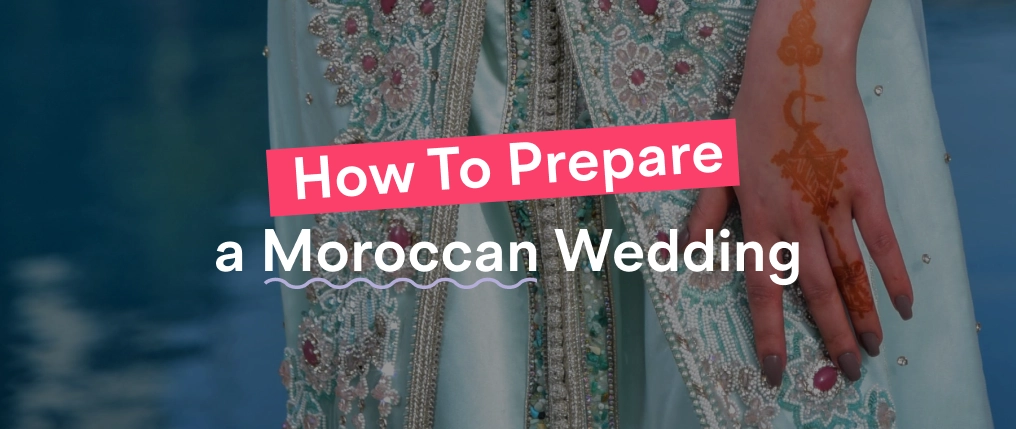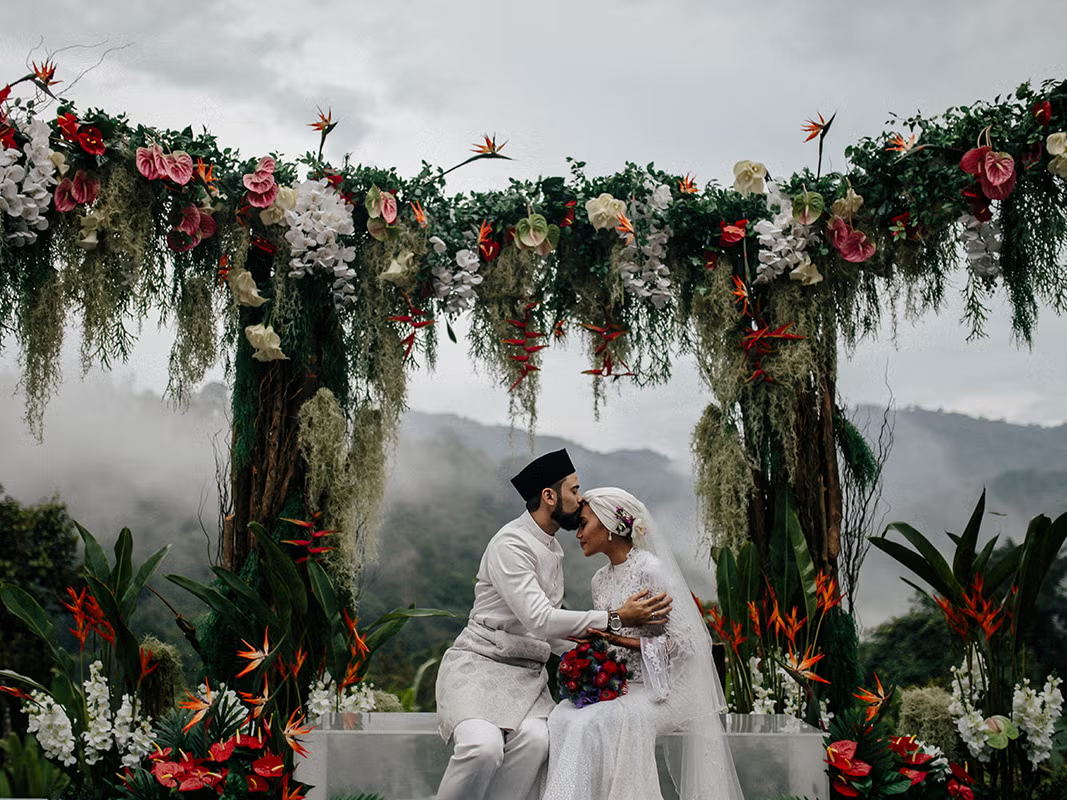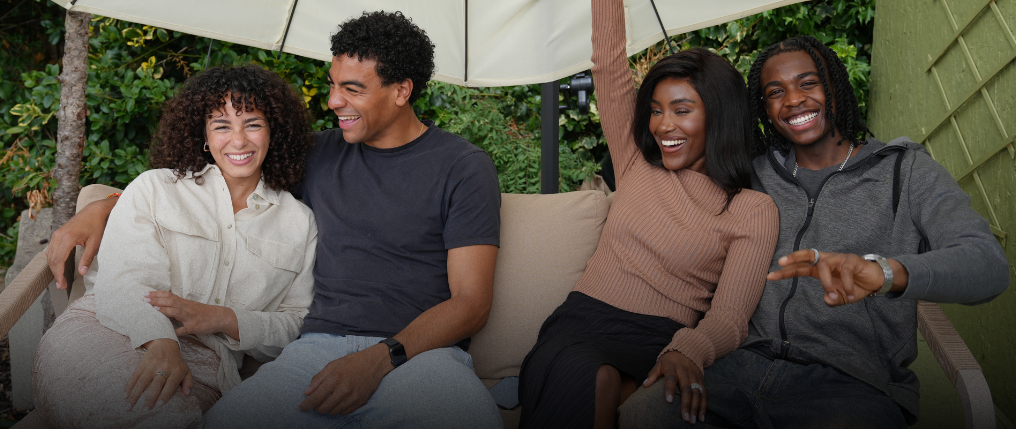
How to prepare a Moroccan wedding
November 14, 2023

A Moroccan wedding is a joyful and festive celebration, rich in specific traditions and rituals. Whether you’re of Moroccan origin or simply want to immerse yourself in this vibrant culture, planning a Moroccan wedding can seem intimidating.


Looking for your soulmate?
You won’t find your soulmate on this blog post but you might find them on Muzz - the world’s biggest Muslim dating and marriage app.
However, with careful preparation and an understanding of the customs, you can organize a memorable wedding that reflects the essence of Moroccan tradition. In this article, we will guide you through the essential steps to prepare for your dream Moroccan wedding.
Table of Contents
Decoration at a Moroccan wedding
Who organizes the Moroccan wedding?
Who pays for the expenses of a Moroccan wedding?
What attire for a Moroccan wedding?
What food to serve at a Moroccan wedding?
Entertainment at a Moroccan wedding
Define your vision

Before you start the preparations, take the time to think about your vision for the wedding. What style of Moroccan wedding do you want? Do you prefer a traditional wedding or a blend of tradition and modernity? Also, consider a wedding theme that inspires you, whether it’s a royal wedding, a Berber wedding, or one with vibrant colours.
Related content: The complete guide to a Muslim wedding
Choose a date and venue

Select a date for your Moroccan wedding, taking into account seasons and holidays. Most weddings in Morocco occur during the summer months, but you can opt for a different season based on your preferences and venue availability. As for the venue, choose a spacious reception hall or a traditional Riad to create an authentic atmosphere.
Invitations and guest list

Design elegant wedding invitations with traditional Moroccan patterns and send them well in advance so that guests can make arrangements. Create a guest list that includes family members, close friends, and important acquaintances. Moroccan weddings are often large, so plan accordingly according to your budget and capacity.
Related content: What to expect at an African wedding as a first-time guest
The Moroccan wedding ceremony

The traditional Moroccan wedding ceremony includes several significant rituals such as the henna, the religious marriage, and the wedding procession called “Zaffa.” Make arrangements for these special ceremonies and hire professionals to help coordinate them. Ensure your guests are informed about the schedules and important details of each ceremony so they can fully participate in these unique moments.
Decoration at a Moroccan Wedding

Decoration plays an essential role in creating the ambience of a Moroccan wedding. Opt for luxurious and colourful fabrics, lanterns, candles, and exotic flowers to adorn your reception venue. Traditional colours include red, gold, green, and blue. Geometric patterns and arabesques are also popular decorative elements.
Related content: What happens at an Arabic wedding
Who organizes the Moroccan wedding?

The responsibility for organizing a Moroccan wedding is typically shared between the bride’s and groom’s families. Traditionally, the bride’s family plays a significant role in planning and organizing the wedding. The mother of the bride, commonly known as “La Kaïma,” is often in charge of coordinating the preparations to ensure everything runs smoothly.
However, in modern times, many couples opt for a more collaborative approach, with the bride and groom actively involved in planning their wedding. They may also hire professional wedding planners to assist in the preparations and ensure that all details are taken care of.
Related content: 6 Egyptian wedding traditions worth knowing about
In any case, it’s important to work closely with your family members and loved ones to organize a successful traditional Moroccan wedding. Each family has its own traditions and customs, so it’s essential to respect everyone’s wishes and expectations while preserving the authenticity of the celebration.
Who pays for the expenses of a Moroccan wedding?

In Moroccan tradition, the expenses of a wedding are typically covered by the groom’s family. It is a common custom for the groom’s family to assume the financial responsibility for the wedding ceremony, including expenses such as venue rental, food, decoration, the attire of the bride and family members, and other event-related costs.
Related content: Mahr in Islam – A Guide for Muslims
However, it’s important to note that this practice can vary based on specific circumstances and agreements between the involved families. Nowadays, more and more couples opt for a modern approach where the costs are shared between both families or even covered by the couple themselves.
Related content: 7 traditions to know before attending a Lebanese wedding
The allocation of expenses can be discussed and negotiated among families to reach a fair and mutually acceptable agreement. Open and honest communication is essential to avoid confusion or tension regarding the financial aspects of a traditional Moroccan wedding.
What attire for a Moroccan Wedding?

For a Moroccan wedding, the bride traditionally wears a gown called a “Caftan.” The Moroccan Caftan is a long, flowing garment, often made from luxurious fabrics such as silk, satin, or velvet. It is lavishly adorned with embroidery, beads, sequins, and traditional Moroccan motifs. The choice of the gown will also depend on the bride’s personal style and preferences.
Here are some popular options for Moroccan wedding attire:
1. Traditional Caftan
A classic Caftan with a loose fit and long sleeves. It can be crafted in a variety of colours, ranging from vibrant tones to pastels, and is often embellished with golden embroidery and motifs.
2. Takchita
The Takchita is a more elaborate version of the Caftan. It consists of two pieces: a form-fitting inner dress called “Dfina” and an outer, more voluminous and decorated dress called “Takchita.” It is typically worn during wedding ceremonies.
3. Modernized with a Contemporary Twist
Some brides choose to modernize their attire by opting for more fitted Caftans, asymmetrical cuts, or modern details while retaining traditional elements such as embroidery and ornaments.
Related content: Tunisian wedding: 7 days and nights of beautiful traditions
It is recommended that the bride consults with designers specializing in Moroccan Caftans or visit specialized boutiques in Morocco to find the perfect gown. It is also common to add accessories such as gold jewellery, a veil, ornate belts, and traditional footwear to complete the Moroccan wedding attire.
Why hire a negafa?

A “negafa” is a person who specialises in assisting and enhancing the bride’s appearance during a Moroccan wedding. The role of the negafa is to make the bride look stunning by ensuring that her attire, hairstyle, makeup, and accessories are impeccable and in line with Moroccan tradition.
The negafa is often considered an important figure at Moroccan weddings, bringing expertise to prepare the bride for the wedding day. She has a deep understanding of Moroccan customs and wedding traditions and knows how to authentically showcase the bride’s beauty.
The responsibilities of a negafa may include:
1. Bride’s Attire
The negafa offers a selection of traditional Moroccan dresses, such as the Caftan, Takchita, or other Moroccan outfits. She helps the bride choose a dress that suits her style while respecting traditions.
2. Hairstyling and Makeup:
The negafa is skilled in creating intricate hairstyles and suitable makeup for the bride. She can create traditional Moroccan hairstyles with braids, hair jewellery, and decorative accessories. Makeup enhances the bride’s facial features using appropriate colours and techniques.
3. Accessories
The negafa also provides accessories like jewellery, belts, veils, shoes, and other decorative items to complete the bride’s look.
4. Advice and Assistance
In addition to aesthetics, the negafa often advises the bride on etiquette and customs during different stages of the Moroccan wedding. She can help the bride prepare for traditional rituals like the henna ceremony and the bridal procession.
The negafa plays a vital role in ensuring the bride’s beauty and elegance at a Moroccan wedding. Her expertise and attention to detail contribute to creating a festive and traditional atmosphere and making the bride
What food to serve at a Moroccan wedding?

A Moroccan wedding is renowned for its delicious and diverse cuisine. Here is a selection of popular traditional Moroccan dishes to serve at a wedding:
- Couscous: Couscous is an iconic Moroccan dish. It is made from wheat semolina accompanied by vegetables and meat (usually lamb or chicken) and flavoured broth. It can be served in separate dishes or as a “royal couscous” with a variety of meats.
- Tajine: Tajines are slow-cooked dishes in conical clay pots. They can be prepared with various ingredients such as chicken, lamb, vegetables, dried fruits, and spices. Tajines offer a combination of sweet and savoury flavours.
- Mechoui: Mechoui is a whole lamb roasted on a spit, seasoned with spices and herbs. It is slow-cooked to achieve tender and flavorful meat. Mechoui is often served at large Moroccan celebrations, including weddings.
- Pastilla: Pastilla is a sweet and savoury dish made from layers of filo pastry filled with pigeon, chicken, or almonds. It is typically dusted with powdered sugar and cinnamon. Pastilla is a Moroccan speciality appreciated for its unique blend of flavours.
- Harira: Harira is a traditional Moroccan soup often served at weddings. It is prepared with vegetables, lentils, chickpeas, tomatoes, spices, and herbs. Harira is a comforting and nutritious dish.
- Moroccan pastries: Moroccan pastries are an essential part of any Moroccan wedding. Delights such as gazelle horns, almond briouates, chebakia (flower-shaped cookies), makrout (date-filled cookies), and msemmen (flaky pancakes) are often served as desserts.
Don’t forget to serve mint tea, an essential beverage in Moroccan culture, along with the pastries to complete the meal.
Make sure to discuss with your caterer to customize your menu based on your and your guests’ preferences.
Entertainment at a Moroccan wedding

Entertainment at a Moroccan wedding plays a crucial role in creating a joyful and lively atmosphere. Here are some of the traditional entertainments that you can find at a Moroccan wedding:
Live Music
Music is a key element in a Moroccan wedding. Traditional Moroccan music groups, such as Gnawa groups, chaabi singers, or orchestras playing Arabic music, are often present to entertain the guests. Guests can dance and participate in festive singing.
Related content: Exploring Walima: A detailed overview and guide
Traditional Dance
Traditional Moroccan dances are an integral part of the entertainment at a wedding. Professional dancers may perform Moroccan folk dances such as belly dance, Ahidous, Reggada, or Saidi. Guests are often encouraged to join in the dance.
The Ziana
The Ziana is a Moroccan tradition where a specialized singer, called a Ziana, entertains the evening by singing traditional wedding songs. She uses her voice to liven up the atmosphere and engage the guests.
The Bride’s Procession
The bride is often welcomed with a festive procession upon her arrival at the wedding venue. Musicians, dancers, and guests come together to create a joyful atmosphere and accompany the bride to her place of honour.
Interactive Games and Entertainment
Traditional Moroccan games can be organized to entertain the guests. For example, the game of “M’kharqa” involves passing a knotted ribbon among guests who must untie it with one hand. Dance, singing, or poetry recitation contests may also be organized to create a playful atmosphere.
Fireworks
Fireworks are often used to mark significant moments in the wedding, such as the entrance of the bride and groom or the cutting of the cake. They add a spectacular and festive touch to the event.
Children’s Entertainment
If children are attending the wedding, entertainers may be present to organize age-appropriate games and activities to keep them entertained and allow them to enjoy the celebration.
These entertainments contribute to creating a joyful, festive, and lively atmosphere at a Moroccan wedding, offering guests a memorable experience while celebrating Moroccan cultural traditions.
Amazigh weddings

An Amazigh wedding, also known as a Berber wedding, is a wedding ceremony that celebrates the traditions and culture of the Amazigh (Berber) populations in Morocco, Algeria, Tunisia, and other North African regions.
Related content: Algerian wedding: 8 traditions you don’t want to miss
Here are some characteristic elements of an Amazigh wedding:
Akhdi Ceremony
The Akhdi is the official ceremony of the Amazigh wedding. It usually takes place at the bride’s parents’ home and is led by an imam or an elder of the community. The bride and groom exchange their vows in front of witnesses and guests.
Traditional Attire
The bride and groom wear traditional Amazigh attire for the ceremony. For the bride, this may include a traditional Berber dress such as a “Takchita” or “Amazighia.” The groom may wear a “Djellaba” or “Jabadour” along with traditional jewelry and accessories.
Henna
As in many cultures, henna holds a significant place in Amazigh weddings. The bride and close female family members apply henna to the bride’s hands and feet, creating artistic patterns. This symbolizes good fortune, fertility, and protection against evil.
Related content: Attending a Henna Party as a Guest? Here’s Your Essential Guide
Amazigh Music and Dance
Amazigh weddings are animated by traditional Berber music and dances. Music groups play instruments such as the bendir (frame drum), ghaïta (flute), and tbel (tambourine). Guests participate in Amazigh dances, such as Ahidous and Ahouach.
Tajellabt Ritual
The tajellabt ritual is an Amazigh tradition where the bride receives a symbolic scarf from the groom’s mother, signifying her welcome into the family and her new role as a wife.
Traditional Feast
The meal at an Amazigh wedding highlights Berber cuisine. It includes traditional dishes such as Berber couscous, tajine, rfissa (a dish made from msemen pancakes and chicken), and other regional specialities.
Community Celebrations
Amazigh weddings are often community events where families and neighbours come together to celebrate. Guests participate in festivities, dances, and songs, creating a joyful and festive atmosphere.
Each Amazigh region has its own specific customs and traditions, so the details and rituals may vary. However, the emphasis on family, culture, music, and celebrating love remains a common element in Amazigh weddings.
Conclusion
So, there you have it, the ins and outs of Moroccan weddings and Amazigh weddings. We’ve explored the tasty dishes, the lively entertainment, and the beautiful traditions that make these celebrations unforgettable.
Remember, whether you’re part of these beautiful traditions or just an enthusiastic guest, Moroccan and Amazigh weddings are all about love, joy, and making cherished memories. So, let’s celebrate these vibrant cultures together and keep the festive spirit alive! Cheers to love and happiness!

